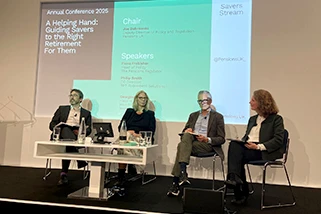Getting retirement guidance right – the future of DC depends on it
TPT’s Philip Smith on the infrastructure and behavioural changes needed now to support retirement income adequacy in the future.

The pension industry stands at a vital crossroads. After over ten years of successful auto-enrolment, more than 30 million[1] people are now saving into defined contribution (DC) pensions. To give some perspective, in 2012, just over 40% of private sector employees participated in a workplace pension, and today, that number has increased to over 80%[2].
Before getting carried away with a job well done, we must remember that auto-enrolment has only been in place for 13 years. This means that pot sizes – while on an upward trajectory – are still relatively small, and all too often overlooked as a primary source of retirement income. More concerningly, they’re frequently seen as a one-off retirement windfall.
The challenge is clear: most people (70%) currently withdraw their entire pension pot without seeking any financial advice or personalised guidance[3]. Not only does this defeat the purpose of a pension—designed to provide a steady income for life—but it also leaves individuals vulnerable to unexpected tax bills, as withdrawing everything usually pushes them into a higher tax bracket. We have seen many cases where, blinded by the temptation of a five- or six-figure sum, people unintentionally expose themselves to unnecessary tax charges. This is a fate that could be avoided if they sought some form of guidance.
Part of the issue is that people simply aren’t taking advice and often don’t trust it, even if it’s free. This is especially frustrating given the existence of Pension Wise, the government service set up to help people understand their pension options. The industry cannot allow this situation to continue. If we do, the very system meant to provide security in later life risks becoming ineffective.
The current government and regulators have correctly recognised this risk. The Financial Conduct Authority’s (FCA’s) recent Advice Guidance Boundary Review and its ongoing consultation into targeted support are positive steps in the right direction. As a sector, we must support this and invest in the products and framework that will make it happen.
At TPT Retirement Solutions, we firmly support the direction outlined by the FCA. We believe that delivering targeted, timely, and actionable guidance at the point of retirement is both vital and urgent.
DC pots are only growing – and so is the problem
The truth is that full, independent financial advice, while beneficial, isn't a practical option for everyone. Costs, complexity, and inertia all factor in. Many people, especially those with savings around £30,000 or less, don't think it’s worth paying for advice. In fact, advisers themselves are unlikely to pay them much attention. However, it is frustrating that they don’t at least seek personalised guidance, even when it would clearly help.
The size of the pot shouldn’t determine whether support is needed. It’s not just about its current value; it’s about the impact it can have in the future. This is where the sector needs to change its mindset. The median value of DC pension pots among those aged 50–59 was £33,500 in 2018–20[4], but this is changing quickly. Pots will soon be much larger — and so will the consequences of poor decision-making.
Put simply: We as an industry must not dismiss the £30,000 problem now, because it will be a six-figure problem in a few years.
Put simply: We as an industry must not dismiss the £30,000 problem now, because it will be a six-figure problem in a few years. Actionable guidance is the future
Build the foundations now, and it will pay dividends
If we wait until pots are large enough to justify advice in the traditional sense, we will have already failed. That’s why we must establish robust guidance frameworks now—for those with £10,000, £30,000, or £50,000. Getting it right today builds the infrastructure and behavioural habits that will support retirement income adequacy in the future.
We must make this work from the outset. The industry has invested significantly in onboarding individuals into the system. The challenge we have set ourselves is that, through a combination of employer contributions, tax relief, and strong investment returns, people will have the chance for a decent standard of living in retirement.
But that promise relies on achieving the right outcomes at the point of retirement, and unless we unite—providers, regulators, schemes, and policymakers—to deliver meaningful, targeted support, that promise will ring hollow for millions.
The default option can no longer be ‘withdraw all’
The support people require isn’t complicated. For someone with a £30,000 pot, this will most likely mean not withdrawing it all at once but rather leaving it in their pension—even if it's sitting in cash. That way, they continue to earn a tax-free return on their investment. When they do withdraw, it should be in small amounts, spread over time, to prevent incurring an unnecessary tax bill. Obviously, everyone’s individual circumstances will need to be considered, but the default option should not be to withdraw it all.
This simple, non-personalised guidance, when made accessible and relevant, could significantly improve outcomes. However, it requires a change in how we deliver information, how we engage with members, and how far schemes are permitted to assist people in making the right decisions.
That’s why the FCA’s consultation on targeted support is so important. It opens the door for schemes to provide clearer, more helpful interventions—without the risk of straying into regulated advice territory. Firms can build guidance into the withdrawal and drawdown process, so that guidance becomes an essential part of the process – rather than an optional extra.
Actionable guidance is the future
TPT has already embedded a level of guidance into the steps leading up to a member accessing their pension, within what the current framework permits. Targeted support will enable us to advance further, focusing on specific cohorts of members with similar lifestyles. This should produce stronger, clearer, and more actionable guidance that assists individuals in navigating the transition from saving to spending.
We are also actively engaging with members to simplify communications and make retirement options easier to understand. However, this needs to be an industry-wide effort. No single provider or scheme can resolve this on its own.
The consequences of inaction are severe. If we do not get this right, the pension system will fail in its most basic goal—to provide people with sufficient income in retirement. And the State Pension, generous as it is in principle, simply will not be enough on its own.
So, let’s not delay. Let’s build the guidance infrastructure now. Let’s help the £30,000 pot holder make the right choices today, so that the £130,000 saver in a few years’ time has a system worth trusting.
We have one shot to get this right, let’s not waste it.
[2] Workplace pension participation and savings trends of eligible employees: 2009 to 2023 - GOV.UK
[4] https://ifs.org.uk/publications/how-important-are-defined-contribution-pensions-financing-retirement
Related news & insights
-

Four independent advisers appointed to support Trustee Board of TPT’s new run-on DB Superfund
The Trustee Board has appointed Gowling WLG to provide legal advice and Mercer as scheme actuary. In addition, LCP will provide independent investment oversight and EY will be the Superfund’s risk advisor. -

TPT hires new Head of Consultant Relations
A central part of Katherine's brief will be to identify and build relationships with employee benefit consultants (EBCs) across the full spectrum of consolidation vehicles TPT offers. -

TPTIM signs up first external fiduciary management client
Dalriada Trustees Limited has become a fiduciary management client on behalf of Paradigm Housing’s Defined Benefit (DB) Pension Plan. This marks the first time TPTIM has co-signed a Fiduciary Management Agreement with an external trustee. -

From pension pot to an income in retirement – driving an industry shift
At the Pensions UK 2025 Conference, TPT's DC Director, Philip Smith, spoke about the kind of guidance members need to help them achieve a simpler, safer, and more secure retirement.
